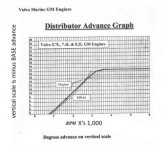A bit beyond me to some degree. Definitely different ignition systems. The rebuilt engine from a year ago also got new distributor/ignition kit. The other engine had the points swapped out for a sensor a couple years ago.
Being anal like I am..... that would bug me.
I would want both engines to be equipped with identical ignition systems, and with identical advance curves.
And BTW.... in my opinion the Pertronix kits are inferior.
They use a cheesy little magnetic embedded plastic Hall Effect wheel in their system.
They also do ZERO to correct an old and malfunctioning advancing system.
I haven't touched the timing on either engine and can't really answer the remaining questions. I guess maybe I need someone to check timing/ignition.
There is not a gasoline engine on earth that will produce maximum power until the ignition advance is correct.
We fire up on BASE advance, and we idle on BASE advance.... and that's it.
Many mechanics will check/set BASE advance only and then call it a day.
A real Marine Mechanic will not only check/set BASE advance, but will also look to see what the Progressive and Total Advance are doing.
This requires increasing engine speed while the ignition timing marks are observed with a strobe light.
If the system is not offering the correct advance curve, then internal changes must be made.
Your BBC ignition advance curve should be fairly linear, and it should be "Full-In" at around 3,200 RPM.
At the Full-In RPM, you should see approximately 28-30 degrees of ignition advance.
(See your OEM ignition curve specs for this data)
Any other suggestions prior to getting timing checked?
Yes... use the tried and proven P of E ....... (process of elimination).
Target, test, check, and if need be replace one item ONLY at a time.
Move to the next suspected item ONLY after the first suspected item has been eliminated.
When used systematically and methodically, the P of E will not let you down!
See attached image below.
This is an example only of what your ignition advance curve may look like.
NOTE: BASE advance value is NOT shown in the vertical scale. When you view the line graph at any intersecting RPM, keep in mind that BASE must be added in order to calculate the dynamic degrees of advance.
Example: look at the ignition advance @ 3,400 RPM.
You will see approximately 22* of advance being shown.
Now add a BASE advance of let's say 8*.
This now gives us a dynamic advance of approximately 30*.


